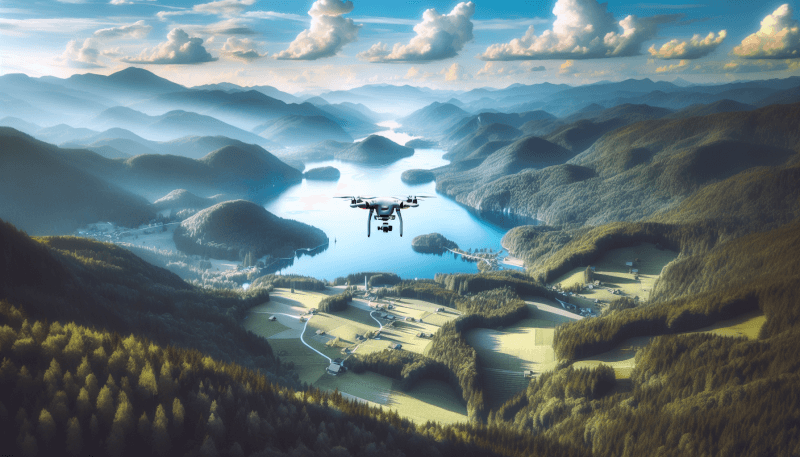Are you ready to take your drone skills to new heights? In this article, we will explore the best techniques and strategies for capturing breathtaking aerial footage with your drone. From finding the perfect location to mastering the art of smooth maneuvers, we will provide you with all the tips and tricks you need to create stunning and cinematic shots from above. So, grab your controller and get ready to elevate your footage to a whole new level of awesomeness!

Choosing the Right Drone
Choosing the right drone is essential to capturing stunning aerial footage. Before making a decision, it’s important to consider the purpose of your aerial footage. Are you looking to capture breathtaking landscapes or action-packed sports scenes? Different drone models offer various features that cater to specific needs. Take your time to research and compare different drone models to find the perfect fit for you.
Consider the purpose of your aerial footage
First and foremost, think about the purpose of your aerial footage. Are you planning to capture cinematic shots for a film, document a special event, or simply explore the beauty of nature from a different perspective? Knowing your purpose will help you determine the specifications and features you should be looking for in a drone.
Research different drone models and features
Drone technology has evolved significantly in recent years, and various models are available on the market. Take the time to research and compare different drone models and their features. Look for drones with high-quality cameras, stable flight capabilities, long battery life, and advanced flying modes. Reading reviews and watching sample footage can also help you make an informed decision.
Evaluate the drone’s camera capabilities
The quality of the camera is one of the most important factors to consider when choosing a drone. Look for drones that offer high-resolution cameras with the ability to shoot in RAW format. This will give you more flexibility during post-processing, allowing you to enhance the final footage. Additionally, drones with built-in gimbal stabilization systems will help ensure smooth and steady shots.
Check the battery life and flight time
Battery life and flight time are crucial factors to consider, especially if you plan to shoot for extended periods or in remote locations. Look for drones with longer flight times so that you can capture more footage before needing to recharge. Keep in mind that battery life may vary depending on factors such as wind conditions and camera usage.
Consider the drone’s size and portability
Another important consideration is the size and portability of the drone. If you’ll be traveling frequently or capturing footage on the go, a compact and lightweight drone will be more convenient. However, keep in mind that smaller drones may have limitations in terms of camera capabilities and stabilization systems. Balance your need for portability with the features you require for your aerial footage.
Understanding Rules and Regulations
Before taking your drone to the skies, it’s essential to familiarize yourself with local drone laws and regulations. Different countries and regions have their own set of rules for operating drones. Research the specific laws in your area, including any restrictions on flying in certain locations or altitudes. Adhering to these regulations not only ensures your safety but also prevents potential legal troubles.
Familiarize yourself with local drone laws
Take the time to study and understand the local drone laws in your area. Pay attention to restrictions on flying near airports, public buildings, or crowded areas. Some areas may also require you to pass a certification exam or obtain a permit before operating a drone. Knowing the rules and regulations will help you fly responsibly and avoid any unnecessary conflicts.
Obtain necessary permits or licenses
In some cases, you may need to obtain permits or licenses to legally operate your drone. This is often the case if you plan to use the footage for commercial purposes or in restricted airspace. Check with local authorities or aviation authorities to determine whether you need any special permissions or certifications. It’s better to be safe and compliant rather than face legal consequences later on.
Respect the privacy of others
When flying a drone, it’s important to respect the privacy of others. Avoid flying over private properties without permission and be mindful of people’s personal space. Drones equipped with cameras can raise concerns about invasion of privacy. Be aware of your surroundings and consider the impact your drone might have on others. Respect any requests to not fly your drone in certain areas.

Follow safety guidelines and restrictions
Safety should always be a top priority when operating a drone. Familiarize yourself with safety guidelines and restrictions provided by drone manufacturers and aviation authorities. These can include maintaining visual contact with your drone at all times, avoiding flying in bad weather conditions, and ensuring your drone is in good working order before each flight. By following these guidelines, you can minimize the risk of accidents and ensure a safe flying experience.
Mastering Basic Flight Techniques
Once you have chosen your drone and familiarized yourself with the rules and regulations, it’s time to master the basic flight techniques. These techniques will not only improve your piloting skills but also help you capture better aerial footage.
Learn how to safely take off and land
Before attempting any complex maneuvers, start by mastering the basics of takeoff and landing. Practice in an open area away from obstacles and people. Ensure that the takeoff and landing surface is level and free of debris or loose objects. Follow your drone’s instructions on how to safely take off and land to avoid any damage to the drone and ensure a smooth flight.
Practice hovering and basic maneuvers
Hovering is an essential skill to master as it allows you to stabilize your drone in one place and capture steady footage. Practice hovering at different altitudes and in various weather conditions. Once you feel comfortable with hovering, move on to basic maneuvers such as flying in straight lines, making turns, and flying in circles. These maneuvers will help you gain confidence and control over your drone.
Understand the drone’s control settings
Take the time to understand the control settings of your drone. Learn which joysticks control the drone’s altitude, direction, and rotation. Familiarize yourself with the different flight modes and settings, such as GPS mode or sport mode. Each drone model may have slight variations in its control settings, so refer to the user manual for specific instructions.
Practice smooth and steady movements
Smooth and steady movements are essential for capturing professional-looking aerial footage. Avoid abrupt or jerky movements that can result in shaky footage. Gradually increase or decrease the drone’s speed and make gentle adjustments to its position. Practice maintaining a consistent speed and altitude to achieve smooth and cinematic footage.
Use the drone’s automated flight modes
Most drones come equipped with automated flight modes that can assist in capturing specific shots or movements. These include features like follow mode, waypoint navigation, and orbit mode. Familiarize yourself with these modes and experiment with them to add variety to your aerial footage. However, always keep in mind that manual control is still necessary for ensuring safety and achieving the desired results.
Planning Your Shot
To capture stunning aerial footage, planning your shots in advance is essential. Pre-visualize the desired footage in your mind, taking into account lighting, weather conditions, and interesting subjects or locations.
Pre-visualize the desired aerial footage
Before taking off, take the time to pre-visualize the shots you want to capture. Imagine how the footage will look from different angles and perspectives. Visualize the composition, the movement, and the overall atmosphere you want to convey. Having a clear vision in mind will help you execute your shots more effectively.
Consider the lighting and weather conditions
Lighting and weather conditions can greatly impact the quality of your aerial footage. Plan your flights during the golden hours, which are the first few hours after sunrise and the last few hours before sunset. This time of day provides soft, warm lighting that is ideal for capturing stunning visuals. Avoid flying in harsh midday sunlight, as it can create strong shadows and blown-out highlights. Additionally, pay attention to weather conditions and avoid flying in high winds or unfavorable weather.

Identify interesting subjects or locations
To capture compelling footage, seek out interesting subjects or locations. Look for landscapes with unique textures, patterns, or colors. Find landmarks or buildings that can add depth and visual interest to your shots. By identifying intriguing subjects or locations, you can create visually captivating aerial footage.
Create a shot list or storyboard
To ensure you capture all the shots you envisioned, consider creating a shot list or storyboard. This will help you stay organized and focused during your flights. List the specific shots you want to capture, including different angles, movements, and subjects. Having a clear plan in place will save you time and ensure that you don’t miss any important shots.
Take advantage of different angles and perspectives
One of the biggest advantages of aerial photography is the ability to capture unique angles and perspectives. Experiment with low-level flights to capture the details of the scenery or try high-altitude shots to provide a broader view. Capture shots from different sides and angles to add variety to your footage. By exploring different angles and perspectives, you can create visually compelling aerial footage.
Utilizing Camera Settings and Modes
To maximize the quality and creativity of your aerial footage, familiarize yourself with the camera settings and modes of your drone. Adjusting exposure settings, utilizing different modes, and experimenting with the manual controls will allow you to capture stunning footage.
Adjust the exposure settings for optimal lighting
To achieve optimal lighting in your aerial footage, adjust the exposure settings of your drone’s camera. Manual exposure control allows you to adjust the aperture, shutter speed, and ISO to achieve the desired exposure. Experiment with different settings to find the right balance and avoid underexposed or overexposed footage.
Experiment with different white balance settings
White balance is another important setting to consider when capturing aerial footage. It determines the color temperature of your footage and affects the overall mood and tone. Experiment with different white balance settings to achieve the desired look and feel. For example, using a warmer white balance setting during sunset can enhance the warm golden hues.
Utilize the drone’s manual camera controls
Many drones offer manual camera controls, allowing you to have more creative control over your footage. Take advantage of these controls to adjust settings such as focus, zoom, and aperture. Manually adjusting these settings can help you create the desired effects and enhance the visual impact of your footage.
Make use of the drone’s auto-tracking features
Some drones come with auto-tracking features that allow the camera to lock onto a moving subject and follow it. This can be particularly useful when capturing action shots or filming fast-moving subjects. Familiarize yourself with your drone’s auto-tracking capabilities and practice using it to capture dynamic and engaging footage.
Try the panoramic or time-lapse modes
Many drones have built-in panoramic and time-lapse modes that can add a unique element to your aerial footage. Panoramic mode captures wide-angle shots by automatically stitching together multiple images. Time-lapse mode compresses an extended period of time into a shorter segment, resulting in captivating footage. Experiment with these modes to add variety and creativity to your aerial footage.
Using Filters and Accessories
Filters and accessories can enhance the quality and creativity of your aerial footage. ND filters, polarizing filters, fisheye lenses, gimbals, and propeller guards can all contribute to smoother shots and better image quality.

Attach ND filters to control light and exposure
ND (Neutral Density) filters are essential for controlling the amount of light entering the camera and achieving proper exposure. They come in different strengths, allowing you to reduce the amount of light without affecting the color balance. ND filters are particularly useful when shooting in bright sunlight or when you want to capture long-exposure shots.
Use polarizing filters to reduce glare and reflections
Polarizing filters are designed to reduce glare and reflections, resulting in clearer and more vibrant footage. They are especially effective when shooting over bodies of water or capturing scenes with glass or shiny surfaces. By reducing unwanted reflections, polarizing filters can improve the overall image quality of your aerial footage.
Explore fisheye or wide-angle lenses
Fisheye or wide-angle lenses can provide a unique perspective and capture a wider field of view in your aerial footage. They allow you to include more of the surroundings in your shots and create a sense of depth. Experiment with different lenses to add variety and create visually interesting aerial footage.
Attach a gimbal for smoother footage
A gimbal is an essential accessory for capturing smooth and stable footage. It stabilizes the camera, compensating for any drone movements, and reduces vibrations and jitters. A gimbal is especially useful when capturing cinematic shots or filming fast-paced action scenes. Invest in a quality gimbal to ensure the highest level of stabilization for your aerial footage.
Consider using propeller guards and landing pads
Propeller guards and landing pads are accessories worth considering for added safety and convenience. Propeller guards can protect your drone’s propellers from damage during flight, especially when flying in tight or confined spaces. Landing pads provide a designated area for takeoff and landing, helping to prevent debris and dirt from damaging the drone or camera.
Understanding Composition and Framing
Composition and framing play a crucial role in capturing stunning and visually appealing aerial footage. Follow these tips to enhance the overall composition of your shots.
Follow the rule of thirds for balanced shots
The rule of thirds is a fundamental principle in photography and can be applied to aerial footage as well. Imagine breaking your shot into a grid of nine equal parts using two vertical and two horizontal lines. Position key elements of your composition along these lines or at their intersections. This technique creates a more balanced and visually appealing shot.
Create depth and leading lines in your compositions
To add depth and visual interest to your aerial footage, look for elements that can create leading lines. These can be roads, rivers, or even rows of trees. Leading lines draw the viewer’s eye into the frame, creating a sense of depth and guiding the viewer’s gaze. Experiment with different angles and elevation to emphasize these leading lines.
Experiment with different perspectives and heights
Aerial photography allows for unique and creative perspectives. Experiment with flying at different heights and angles to capture a variety of shots. Fly high for a broader view or fly low for a more intimate and detailed perspective. By exploring different perspectives, you can create visually engaging and dynamic footage.
Include foreground elements for added interest
Adding foreground elements to your shots can enhance the overall composition and add depth. Look for objects such as trees, buildings, or rocks that can serve as interesting foreground elements. These elements provide a frame within the frame and add visual interest to your footage. Experiment with different compositions to find the right balance between the foreground and the background.

Avoid excessive camera movements
While drones allow for dynamic camera movements, it’s important to avoid excessive movements that can result in shaky footage. Keep camera movements smooth, gradual, and purposeful. Plan your movements in advance and practice executing them with precision. Smooth camera movements will create a more professional and visually appealing result.
Mastering Advanced Techniques
Once you have mastered the basics, it’s time to take your aerial footage to the next level. Experiment with advanced techniques to capture truly extraordinary shots.
Practice manual camera movements and tilts
In addition to using the automated flight modes, practice manual camera movements and tilts to add variety and creativity to your shots. Adjust the camera angle during flight to capture different perspectives or create unique visual effects. Manual camera movements can add a personal touch to your aerial footage and showcase your creativity as a drone pilot.
Experiment with aerial hyperlapse and tracking shots
Aerial hyperlapse is a technique that involves capturing a time-lapse video while the drone is in motion. This creates a cinematic effect, showcasing the passage of time and the changing scenery. Experiment with hyperlapse shots while tracking a moving subject or flying along a predetermined path. This technique can result in visually stunning and captivating footage.
Try orbiting or circling around a subject
Orbiting or circling around a subject is a technique that can add depth and movement to your shots. Fly in a circular path around the subject of interest, adjusting the radius and altitude as needed. This technique can create visually appealing footage and showcase the subject from different angles.
Learn how to fly smoothly at higher speeds
Flying smoothly at higher speeds can be challenging but is essential for capturing dynamic shots. Practice flying at faster speeds while maintaining stability and control. Gradually increase the speed as you gain confidence and ensure that your shots remain steady and free from vibrations.
Combine different techniques for unique shots
To truly stand out in the world of aerial photography, don’t be afraid to combine different techniques. Experiment with aerial hyperlapse shots while incorporating manual camera movements or circling around a subject. This combination of techniques can result in unique and visually striking footage that sets your work apart.
Editing and Post-Processing
Once you have captured your footage, it’s time to bring it to life through editing and post-processing. Follow these steps to enhance the quality and impact of your aerial footage.
Transfer the footage to your computer
After each flight, transfer the footage from your drone to your computer. This can be done using a USB cable, memory card reader, or wireless transfer. Organize your footage into specific folders to make it easier to locate and access during the editing process.
Organize and select the best clips
Review your footage and select the best clips for editing. Remove any footage that is repetitive, out of focus, or does not meet your desired quality standards. Organize your clips into different folders based on shots or scenes, making it easier to navigate during the editing process.
Use video editing software to trim and stabilize
Video editing software is a powerful tool for trimming and stabilizing your footage. Trim unnecessary segments, combine different clips, and rearrange the sequence to create a cohesive storyline. Take advantage of stabilization features to further enhance the smoothness of your footage and eliminate any unwanted vibrations or jitters.
Apply color correction and enhance the visuals
Color correction is an essential step in post-processing to enhance the visuals of your aerial footage. Adjust the exposure, contrast, saturation, and white balance to achieve the desired look and feel. Fine-tune the colors to bring out the vibrancy and detail of the scenery. Experiment with different color grading techniques to create a unique visual style.
Add music and sound effects to enhance the experience
To elevate the overall viewing experience of your footage, consider adding music and sound effects. Choose music that complements the mood and tone of your footage, whether it’s upbeat and energetic or serene and calming. Add sound effects, such as the buzzing of the drone or ambient sounds, to create a more immersive and engaging experience for the viewer.
Sharing and Showcasing Your Work
Now that you have created stunning aerial footage, it’s time to share and showcase your work. Follow these steps to share your footage with others and gain recognition for your skills.
Upload your footage to a cloud storage or hosting platform
To ensure widespread accessibility, upload your footage to a cloud storage or hosting platform. This will allow you to easily share your footage with others and provide a platform for viewing and downloading. Choose a platform that aligns with your needs and offers the necessary features, such as privacy settings and embedding options.
Share your aerial videos on social media
Social media platforms are an excellent way to showcase your aerial footage and reach a wider audience. Share your videos on platforms such as YouTube, Instagram, or Facebook, and use relevant hashtags to increase visibility. Engage with your audience by responding to comments and encouraging discussions about your work.
Join drone communities and share your experiences
Joining drone communities is a great way to connect with fellow drone enthusiasts and share your experiences. These communities provide a supportive environment where you can learn from others, receive feedback on your work, and discover new techniques or locations. Actively participate in discussions, share your own tips and insights, and celebrate the achievements of others.
Enter drone film festivals or competitions
Drone film festivals and competitions provide an opportunity to showcase your skills and gain recognition for your work. Research and identify relevant festivals or competitions that align with your goals and submit your best footage. Participating in these events not only allows you to receive feedback from industry professionals but also opens doors to new opportunities and collaborations.
Create a professional portfolio or showcase website
To present your work in a professional and organized manner, create a portfolio or showcase website. Display your best aerial footage, provide information about your skills and experience, and include contact details for potential collaborations or inquiries. A dedicated website can serve as a digital resume and make it easier for clients or collaborators to explore your work and reach out to you.
In conclusion, capturing stunning aerial footage with your drone requires careful consideration of the right drone model, understanding rules and regulations, mastering flight techniques, planning your shots, utilizing camera settings and accessories, understanding composition and framing, mastering advanced techniques, editing and post-processing, and sharing and showcasing your work. By following these comprehensive guidelines, you can elevate your aerial footage to new heights and create visually stunning content. Happy flying!


